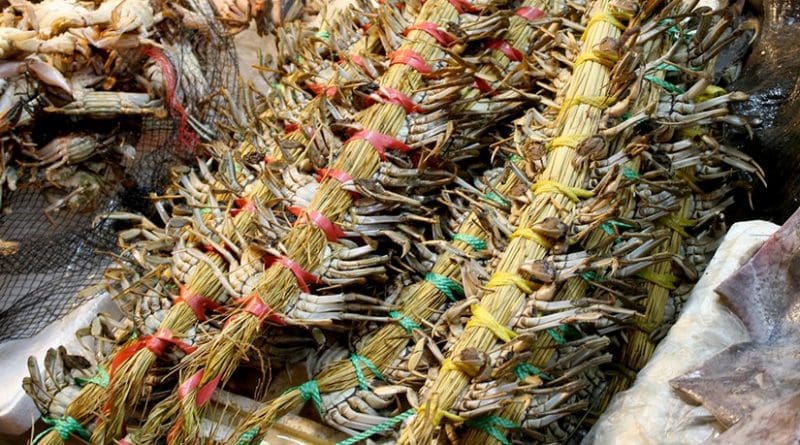Tensions In The Yellow Sea: Crabs And The Inter-Korea Border Dispute – Analysis
By RSIS
There has been intensified competition between fishermen from China, South Korea and North Korea to catch blue crabs around the disputed Northern Limit Line (NLL) in the Yellow Sea. As long as the maritime boundary between the two Koreas remains disputed, Chinese fishermen will continue to enter those waters.
By Shawn Ho*
After the Korean War was brought to a halt with the signing of the 1953 Armistice Agreement, the US-led United Nations Command in charge of defending South Korea drew up a maritime border to the west of the land-based Demilitarised Zone (DMZ). South Korea’s position is that North Korean ships are prohibited from crossing this maritime border known as the NLL. North Korea, however, does not recognise the NLL. This disputed maritime boundary between the two Koreas has led to exchange of fire in several deadly clashes over the years.
Fishermen from the two Koreas also have great interest in the disputed NLL area, especially during the peak blue crab season in June. In recent years, there has also been an increase in the number of Chinese fishermen who venture into this zone to catch these crabs due to their soaring prices – one kilogramme of blue crabs in China are reportedly sold for about US$30 now which is a three-fold increase from last year and a nine-fold increase from 2014. As a result of increased Chinese fishing, South Korea’s blue crab harvest in the first five months of this year reached only one third of what was caught in the same period last year, and less than one sixth of the corresponding figure for 2014, according to South Korea’s Yonhap News.
Increasing Risk of Clashes
Since the two Koreas have been unable to agree to a common maritime boundary in the Yellow Sea, Chinese fishermen have made use of this ambiguity and continued to profit from it by manoeuvring strategically around and within the disputed waters. When detected catching crabs in either South or North Korean waters, these Chinese boats avoid further pursuit from both South and North Korean ships by crossing into the disputed zone. Both Korean ships typically do not venture into this disputed zone for fear of being shot at by the other Korea’s forces.
The increase in the presence of Chinese fishermen near the Korean Peninsula has prompted the South Korean military and the UN Command in South Korea to launch their first-ever joint crackdown operation in June this year to push away Chinese fishing boats which numbered around 300 a day. Some South Korean fishermen have even taken matters into their own hands to capture the Chinese fishing boats
To protect their respective fishermen from what they deem as illegal Chinese competition, South and North Korean coast guard vessels will increasingly be deployed in the disputed NLL area. Given the high levels of inter-Korean tensions in recent years and a lack of communication between them, any miscalculation from either party could trigger clashes between their civilian and/or military ships. Recent clashes include the exchanging of warning shots by North and South Korean ships after a North Korean patrol boat crossed the disputed NLL in October 2014.
Measures to Prevent Future Clashes
Looking ahead, the presence of Chinese fishing boats in this disputed zone is likely to increase in the future, which will further complicate this inter-Korean boundary issue and increase the risk of clashes between ships of all three countries. It is in the best interests of all parties involved to avoid the re-occurrence of potentially fatal clashes, such as the 2011 incident in which a Chinese fishing boat captain stabbed a South Korean officer who had boarded the boat to arrest the crew.
This continuing ambiguity of the maritime boundary will only embolden more Chinese fishermen to enter the disputed zone. As Korean re-unification is unlikely to happen in the foreseeable future and the disputed NLL issue will remain, it is vital that the two Koreas re-start dialogue and aim to fully resolve this maritime boundary issue.
Realistically speaking, however, achieving such a resolution will take a long time. An immediate measure that can be implemented could be a “No Crabbing Zone” in a certain section of the disputed NLL area where clashes are most likely to happen. Both Koreas must emphasise that this proposed zone has nothing to do with the sovereignty of those disputed waters.
Benefits of No Crabbing Zone
This would mean that no civilian or military ships are allowed to sail within this zone except for patrol vessels from an external and neutral party such as the UN Command. South Korea has already shown its willingness to work with the UN Command in June this year. By establishing such a zone, there are two major benefits: (1) it keeps the fishing vessels from various countries apart in the areas where they are most likely to clash over the same crab stocks; (2) the depleted crab supplies will be allowed time to re-populate leading to a more sustainable stock of crabs for the future livelihood of Korean fishermen.
Despite this “No Crabbing Zone”, Korean fishermen will still be able to catch crabs in their respective waters. Since the UN Command will patrol this “No Crabbing Zone”, the coast guards of both Koreas can channel some of their vessels to focus on preventing the large number of Chinese fishing boats from entering Korean waters. This stricter enforcement of no entry for Chinese ships into Korean waters is equally important in preventing clashes between Korean and Chinese ships.
The two Koreas and China should accept that in the larger scheme of things, crabs are ultimately not worth fighting over, especially if they will lead to an increase in maritime tensions, clashes and potential fatalities involving Koreans and Chinese.
*Shawn Ho is an Associate Research Fellow with the Regional Security Architecture Programme, S. Rajaratnam School of International Studies (RSIS), Nanyang Technological University, Singapore.

